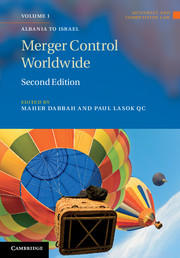Book contents
- Frontmatter
- Contents
- Preface
- List of Contributors
- Table of cases
- Table of Legislation and Official Guidance
- Introduction
- Albania
- Argentina
- Armenia (Republic of Armenia)
- Australia
- Austria
- Barbados
- Belgium
- Bosnia and Herzegovina
- Brazil
- Bulgaria (Republic of Bulgaria)
- Canada
- Chile
- China*
- Costa Rica
- Croatia
- Cyprus (Republic of Cyprus)
- Czech Republic
- Denmark
- Estonia
- European Economic Area
- European Union
- Finland
- France
- Germany (Federal Republic of Germany)
- Greece
- Hong Kong
- Hungary
- Iceland
- India
- Indonesia (Republic of Indonesia)
- Ireland
- Israel
- Italy
- Japan
- Kenya
- Korea
- Latvia
- Lithuania
- Macedonia (Republic of Macedonia)
- Malta
- Mexico
- Netherlands (The Netherlands)
- New Zealand
- Norway
- Pakistan
- Peru
- Philippines (Republic of the Philippines)
- Poland
- Portugal
- Romania
- Russia
- Serbia
- Singapore
- Slovakia (Slovak Republic)
- Slovenia
- South Africa
- Spain
- Sri Lanka
- Sweden
- Switzerland
- Taiwan
- Thailand
- Tunisia (Republic of Tunisia)
- Turkey
- Ukraine
- United Kingdom
- United States of America
- Uzbekistan
- Venezuela
- Zambia
- Index
Germany (Federal Republic of Germany)
Published online by Cambridge University Press: 05 November 2014
- Frontmatter
- Contents
- Preface
- List of Contributors
- Table of cases
- Table of Legislation and Official Guidance
- Introduction
- Albania
- Argentina
- Armenia (Republic of Armenia)
- Australia
- Austria
- Barbados
- Belgium
- Bosnia and Herzegovina
- Brazil
- Bulgaria (Republic of Bulgaria)
- Canada
- Chile
- China*
- Costa Rica
- Croatia
- Cyprus (Republic of Cyprus)
- Czech Republic
- Denmark
- Estonia
- European Economic Area
- European Union
- Finland
- France
- Germany (Federal Republic of Germany)
- Greece
- Hong Kong
- Hungary
- Iceland
- India
- Indonesia (Republic of Indonesia)
- Ireland
- Israel
- Italy
- Japan
- Kenya
- Korea
- Latvia
- Lithuania
- Macedonia (Republic of Macedonia)
- Malta
- Mexico
- Netherlands (The Netherlands)
- New Zealand
- Norway
- Pakistan
- Peru
- Philippines (Republic of the Philippines)
- Poland
- Portugal
- Romania
- Russia
- Serbia
- Singapore
- Slovakia (Slovak Republic)
- Slovenia
- South Africa
- Spain
- Sri Lanka
- Sweden
- Switzerland
- Taiwan
- Thailand
- Tunisia (Republic of Tunisia)
- Turkey
- Ukraine
- United Kingdom
- United States of America
- Uzbekistan
- Venezuela
- Zambia
- Index
Summary
In Germany, as a Member State of the European Union, European competition law acts in parallel with the German provisions. Although this contribution is confined solely to describing the German system, it would be helpful to start by briefly describing the relationship between the two merger control systems.
The Act against Restraints of Competition (ARC) reaches its jurisdictional limit in cases where the Commission of the European Union (‘the European Commission’) has exclusive jurisdiction. According to recital 8 of the preamble to the European Community (EU) Merger Control Regulation (EUMR or ‘the Regulation’), EU law shall apply to mergers which cause significant structural changes, the impact of which goes beyond the national borders of any one Member State. A merger is within the scope of the Regulation if it is a concentration as defined in Article 3 EUMR and has a so-called Community dimension. Pursuant to Article 1 EUMR a concentration has a Community dimension where the combined aggregate worldwide turnover of all the undertakings concerned is more than €5,000 million and the aggregate Community-wide turnover of each of at least two of the undertakings concerned is more than €250 million unless each of the undertakings concerned achieves more than two-thirds of its aggregate Community-wide turnover within one and the same Member State. A concentration that does not meet these thresholds has a Community dimension where the combined aggregate worldwide turnover of all of the undertakings concerned is more than €2,500 million, in each of at least three Member States the combined aggregate turnover of all the undertakings concerned is more than €100 million, in each of at least three Member States included for the aforementioned purpose the aggregate turnover of each of at least two of the undertakings concerned is more than €25 million, and the aggregate Community-wide turnover of each of at least two of the undertakings concerned is more than €100 million, unless each of the undertakings concerned achieves more than two-thirds of its aggregate Community-wide turnover within one and the same Member State (for more details, please see the chapter on merger control in the EU). Furthermore, a concentration which does not have a Community dimension may in certain cases be referred to the European Commission. This can be done either by the relevant undertakings, the prerequisite being that the concentration is capable of being reviewed under the national competition laws of at least three Member States, or by one or more of the Member States, the prerequisite being that it affects trade between Member States and threatens to significantly affect competition within the territory of the Member States or State making the request. It is also possible for the reverse scenario to arise, where the European Commission refers a notified concentration to the competent authorities of the Member States pursuant to Article 9 EUMR. Where the European Commission has jurisdiction to deal with a concentration, it will be exclusively reviewed at EU level, thus excluding any competence on the part of the national authorities. The remainder of this chapter discusses the residual competence of the German merger control authorities.
- Type
- Chapter
- Information
- Merger Control Worldwide , pp. 556 - 594Publisher: Cambridge University PressPrint publication year: 2012



